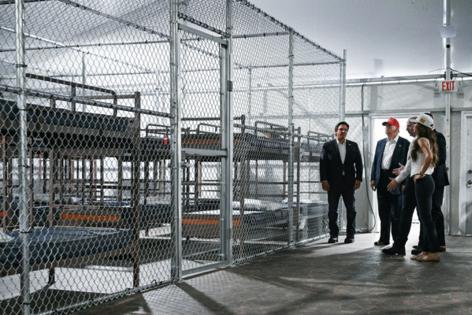Cubans fear limbo at Alligator Alcatraz. What it shows about Trump immigration plan
Published in News & Features
MIAMI – For much of July, Pedro Lorenzo Concepción was held at Alligator Alcatraz along with dozens of other Cuban nationals in a detention camp billed as a last stop for immigrants slated for deportation — an unnerving situation for someone whose repatriation had already been rejected by the Cuban government.
He begged staff at the facility to offer some clarity on his fate, but received no response, according to his longtime partner, Daimarys Hernández. He was eventually transferred this month to Krome detention center, where he is still waiting to learn what will happen to him.
Lorenzo Concepción, 44, is among hundreds of Cubans who at one time or another have been held at the site since the first detainees arrived on July 2, according to records obtained by the Miami Herald and Tampa Bay Times. Roughly half of them had been ordered removed from the United States by immigration judges.
Cuba does not always readily accept citizens deported by the United States, especially those with criminal records. It leaves open the possibility that Lorenzo Concepción — who has prior convictions for marijuana trafficking and credit card fraud — and others like him may be indefinitely detained or transferred to “third” countries like the two Cubans recently moved to war-torn South Sudan.
“There’s tremendous uncertainty,” Hernández said in an interview.
Cuban migrants held in detention centers across the country are unclear about what their future holds.
Turbocharged enforcement of immigration laws and ramped up deportation efforts since President Trump returned to the White House has meant Cuban immigrants — who for decades enjoyed a quicker and easier path to American residency and citizenship compared to other immigrant communities — are increasingly finding themselves in the crosshairs of immigration officials.
The change has perhaps been most evident in South Florida, which for decades welcomed exiles fleeing the Castro regime. Now recently arrived Cubans, including those seeking asylum, are vulnerable. The stricter enforcement coincides with a record wave of Cuban migrants leaving worsening economic conditions and increased political repression.
The United States has historically limited deportations to Cuba because of Havana’s restrictive conditions for accepting returnees and fears that the Cuban government could persecute them upon their return. To get around that challenge, the Trump administration is aggressively deporting Cubans to countries like Mexico, where they lack any legal status or protection from violence and exploitation.
“It’s heartbreaking,” said Ana Sofia Pelaez of the advocacy group, Miami Freedom Project. “There’s a dissonance between how Americans, especially some lawmakers, talk about Cubans fleeing the island and how they are now being treated in the United States.”
Records analyzed by the Herald/Times showed that roughly 200 Cubans were detained at the Everglades facility at the end of July. The numbers fluctuate, with detainees being transferred in and out of the site, and the Department of Homeland Security said that only 50 Cubans remained on Wednesday.
Tricia McLaughlin, assistant secretary for public affairs for the Department of Homeland Security, said that ICE is targeting “the worst of the worst,” including “terrorists” and “pedophiles.”
“If Cuba does not want to accept deportees, it is because they are barbaric criminals,” she said.
From Mariel to Alligator Alcatraz
U.S. Immigration and Customs Enforcement has just about doubled the number of detainers issued against Cuban migrants each month since he took office, according to a Herald analysis of data from ICE obtained by the University of California, Berkeley-based Deportation Data Project.
ICE arrested roughly 150 undocumented migrants from Cuba on average each month in 2024, the data shows. That figure has shot up to around 500 in 2025. ICE arrested around 600 Cubans in May and more than 1,000 in June.
These figures are almost certainly undercounts: The data is likely not exhaustive and the real number of Cubans currently targeted by immigration authorities is likely higher.
The Herald has also witnessed ICE pick up Cubans with pending residency and asylum cases after their hearings as part of the agency’s high-profile enforcement actions in immigration courts across the country.
“I’ve been an immigration lawyer for over 40 years and before this I’ve never had a Cuban seeking asylum go to court and get detained in court,” said Miami immigration attorney Wilfredo O. Allen. “This has never happened before.”
Cuban immigration to the United States picked up in the aftermath of the Cuban Revolution in 1959. Waves of refugees arrived in Florida in subsequent decades. The 1967 Cuban Adjustment Act expedited a pathway to American residency for the recently-arrived exiles.
The influx of Cuban immigrants spiked in 1980 with the Mariel Boatlift — a pivotal moment for U.S. immigration policy and the Cuban diaspora — when around 120,000 Cubans arrived in South Florida.
Faced with this massive exodus, the Carter administration announced the Cuban-Haitian Entrant Program that same year, granting special status to those who came during this exodus. The status makes them eligible for the same benefits — like SNAP and supplemental Social Security income — as refugees, unlike most other immigrant groups.
Immigration policies for Cubans have been increasingly tightened over the last decade.
President Barack Obama repealed “wet foot, dry foot” — a decades-old policy that generally allowed Cubans who reached American soil to stay.
In recent years, tens of thousands of Cubans have had a harder time getting residency under existing law because of the way authorities processed them when they crossed the U.S.-Mexico border, according to South Florida immigration attorneys.
And in March, the Trump Administration revoked the humanitarian parole program through which over 200,000 Cubans had entered the United States legally under the Biden administration. Their immigration status is now at risk and they are potentially subject to arrest and deportation.
When Castro opened the Port of Mariel to fleeing Cubans four decades ago, overwhelmed local and federal agencies shepherded those without any prior connection to the U.S. to makeshift tent cities under the I-95 overpass along the Miami river. The sites were chaotic but also symbols of hope and refuge.
Today’s Cuban migrants like Pedro Lorenzo Concepción are being sent under guard to another tent city — Alligator Alcatraz.
Attorneys and families of detainees have described the detention camp as a place where migrants are held in limbo in harsh and unsanitary conditions, with little access to legal resources.
Among them was Lorenzo Concepción, who fled Cuba nearly two decades ago and is now a father to three U.S.-born children, two of them his biological sons, his partner said. He was detained by ICE in early July during a routine check-in at the agency’s Miramar office. After repeated attempts to get some answers regarding his future went in vain, he stopped eating for a week in protest, his partner told the Herald.
McLaughlin, the DHS spokesperson, dismissed Lorenzo Concepción’s story of a hunger strike as lies concocted by a criminal. She added that when there is a hunger strike, the well-being of those in its custody is a top priority: “ICE continues to provide three meals a day, delivered to the detained alien’s room, and an adequate supply of drinking water or other beverages.”
The office of Gov. Ron DeSantis, whose administration oversees operations at the facility, also denied accounts of any hunger strikes. It did not respond to the Herald’s questions about the plight of the Cubans.
Lorenzo Concepción was transferred from Alligator Alcatraz to the Krome detention center in Miami last week. There is still little clarity on what will happen next.
“We continue to wait to see what will happen,” Hernández, his partner, told the Herald on Monday.
Uncertain futures
While Cuba typically accepts one deportation flight from the United States each month, the country is very selective about the returnees it lets back in, often refusing to take back those with criminal convictions.
With convictions on his record, Lorenzo Concepción knew he was at risk of being deported. ICE had already tried to expel him once before. But Cuba, Hernández said, would not take him back and he has remained in the United States.
American immigration officials are increasingly transferring such immigrants to a third country. To avoid being sent to one, migrants must prove that they would be harmed in such a place — a difficult legal burden.
The longer Lorenzo Concepción goes without answers regarding his status and the outcome of his case, the more terrified he becomes about being sent to an unfamiliar nation, his partner told the Herald.
Allen, the immigration attorney, said he has Cuban clients who have been dropped off at Mexico, where they have no legal status and often no support system.
“They were put on a bus, taken across the border … and it was like ‘Hey, get out and get lost,’” he said.
Attorneys like him are worried that their clients, especially those from Cuba, Venezuela, Haiti and Nicaragua, who are deported to countries where they were not born and are not citizens could become stateless, get stuck in immigration limbo and lose most of their rights and protections for the rest of their lives.
“I don’t think this [U.S.] government has any worries about that,” Allen said. “Once a third country accepts them, the United States could care less.”
©2025 Miami Herald. Visit at miamiherald.com. Distributed by Tribune Content Agency, LLC.







Comments